Vudu is the precision optic line of products brought to you through EOTech. You may know EOTech from introducing military holographic weapon sights in 2001, 5 years after revealing a holographic optic in conjunction with Bushnell. Since then, you can’t swing a bushel of Kandahar Kush without running into a US warfighter using the beloved “donut of death” to introduce martyrs to 72 virgins (if you believe that sort of thing. I don’t, but the only good martyr is a dead one, right?).
SOCOM has used early models of EOTechs since 2001, and I still remember my issued 553 model. We actually just got the new EXPS models delivered to the team room last year to address the infamous temperature issues with the earlier models. No problems since with temperature drift, to EOTech’s credit. I’d also be remiss if I didn’t mention that EOTech, in response to the temperature drift fiasco, covered the consumer by issuing a full credit or refund to affected customers. High-class company if you ask me.
In 2016, EOTech introduced the Vudu line of precision rifle scopes. They’re still relatively new, but you can go to any local 3 gun or Precision Rifle Series match and find someone using one of these optics. They run the gamut in magnification to the ever-popular run and gun 1-6x to an 8-32x model for extreme long range shooting. If you’re looking for a magnified optic at a competitive price point, take a look at the Vudu line.
Rifle Scopes
Vudu 1-6x Precision Rifle Scope
The 1-6x variant will surely be a favorite for 3 gunners or folks looking to build a recce rifle. This optic is a low power variable optic (LPVO) and is a fantastic all-around option, especially for AR-type rifles. What I like about the Vudu 1-6x is how well it compares to the Vortex Razor 1-6x (which many would consider the gold standard for LPVOs).
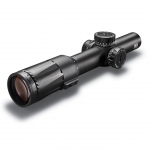
‘Donut of Death’
The Japanese glass, just like the Razor, is extremely clear and has great edge-to-edge clarity. My favorite feature of this optic is the aforementioned “donut of death” reticle is preserved. When looking through the optic on 1x, the reticle looks exactly like looking through an EOTech 553 or EXPS. Only when you power up to higher magnifications is the finer crosshair or BDC revealed. The Vudu is smaller and lighter than the Vortex offering, but not by much. A really cool carry-over feature from EOTech holographic weapon sights is the auto-off feature. That means your Vudu illumination will automatically shut off after 2 hours to better conserve your battery life.
BDC Reticle and Illumination
Where the Vudu needs improvement is the BDC reticle and illumination. The SR-2 and SR-3 BDC reticles will absolutely need some tinkering to ensure your rifle and projectile will match up to the BDCs. The SR-1, on the other hand, is a standard crosshair with hashes that will work with any combination of caliber and rifle. The reticle brightness leaves much to be desired, but it’s a common problem with LPVOs. The red LED appears to bleed a bit throughout the reticle, giving it a splotchy appearance. Not a deal-breaker, but something to consider.
Overall, it’s a very usable scope, especially for 3 gun purposes. The reticle on 1x is superb and allows for high-speed target engagements. The glass clarity is on par with optics in a much higher price range, and the battery saving feature is a great touch.
Specifications
- Magnification: 1-6x
- Objective diameter: 24mm
- Tube diameter: 30mm
- Reticle Focal Plane: First Focal Plane (FFP)
- Reticle: SR-1 (MRAD), SR-2 (7.62 BDC), or SR-3 (5.56 BDC)
- Dial Adjustment: MOA
- Linear Field of View: 16.7-102.4’ at 100 yds (max to min magnification)
- Illumination: Yes, red
- Eye Relief: 3.1-.3.9”
- Length: 10.63”
- Weight: 19.75 oz
- Price: $999.99 from Optics Planet and Palmetto State Armory
Vudu 2.5-10x Precision Rifle Scope
The next offering from EOTech’s Vudu line is the 2.5-10×44 scope. To me, this is a great mid-range scope as it reminds me of the venerable Leupold Mk4 MR/T 2.5-10x. Where EOTech improved upon the old Leupold is having a 44mm objective lens. The wider the objective lens, the more light is collected, and the clearer the glass appears. 44mm is a good choice because it’s small enough to still mount on an AR without necessitating an abnormally tall mount.
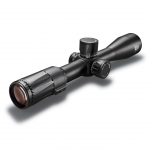
The Reticle
What I like about this optic is the reticle: you can order this bad boy with a Horus H59. This is one of my all-time favorite reticles because it works across a range of calibers and rifles. Holding for windage and elevation is… wait for it… “a breeze!” I couldn’t help myself, but you get the idea. It’s effortless.
Just like the Vudu 1-6x, the 2.5-10x inherited the auto-off feature and extremely clear glass. The non-H59 reticles are simple crosshairs in MRAD or MOA dimensions, which any military shooter will appreciate.
For a scope this size, you’d usually expect a 30mm main tube. However, this optic is a 34mm deal. This isn’t necessarily a negative, but it definitely feels quite a bit beefier (though not necessarily heavier) than a comparable scope. Don’t worry, you’ll be able to find whatever rings or mounts you want as everyone makes a 34mm set. (I love Leupold, but their new 35mm Mk5 is weird).
This is an excellent option for a recce rifle (think Mk12 or 18” AR) or hunting rifle. You can make good engagements out to 800m, no problem with this magnification range.
Specifications
- Magnification: 2.5-10x
- Objective diameter: 44mm
- Tube diameter: 30mm
- Reticle Focal Plane: First Focal Plane (FFP)
- Reticle: MD-1 (MRAD), MD-2 (MOA), or H59 (MRAD)
- Dial Adjustment: MD-1 and H59: MRAD; MD-2: MOA
- Linear Field of View: 10.2-41’’ at 100 yds (min to max magnification)
- Illumination: Yes, red
- Eye Relief: 3.2-.3.9”
- Length: 14.84”
- Weight: 30.97 oz
- Price: $1149.99 at Optics Planet
Vudu 3.5-18x Precision Rifle Scope
With 3.5-18x, we can start to get into the long range game with much more precision. This is a great overall magnification range to go on a ram hunt in the mountains or compete in a Precision Rifle Series match.

MD-1, MD-2 Reticles
I’m not super crazy about the MD-1 or MD-2 reticles, but they are simple and easy to use for a variety of purposes. The benefit of this bad boy is that you can have it with the excellent H59. We’ll eventually have to do a whole piece on the H59 and other tree-style reticles, but check out this link for a little explanation. Todd Hodnett is the modern godfather of long-range shooting and developed a lot of the formulas in modern ballistic apps. This dude literally drew up a new reticle for the 6.5 Creedmoor on a napkin for the US Army contract.
Like everything else in the Vudu line, this 3.5-18×50 version has excellent glass quality and edge to edge clarity. It’s heavy, but it’s still nearly 10oz lighter than the Vortex Razor 3-18x. That is a significant difference when you’re humping a bolt gun around through the Appalachian Mountains, believe me. The eye relief did take a little getting used to, but that could also be because I’ve been using LPVOs a lot recently. I only found it an issue in awkward positions, but after a few training reps, I was good to go.
Specifications
- Magnification: 3.5-18x
- Objective diameter: 50mm
- Tube diameter: 34mm
- Reticle Focal Plane: First Focal Plane (FFP)
- Reticle: MD-1 (MRAD), MD-2 (MOA), or H59 (MRAD)
- Dial Adjustment: MD-1 and H59: MRAD; MD-2: MOA
- Linear Field of View: 5.7-29.5’’ at 100 yds
- Illumination: Yes, red
- Eye Relief: 3.5-.4”
- Length: 14.84”
- Weight: 33.6 oz
- Price: $1299.99 (MD-1 and MD-2); $1499,99 (H59) at Optics Planet
Vudu 8-32×50 SFP
This, along with the 5-25x, are EOTech’s submissions into the extreme long-range shooting disciplines. The only thing I really have to say about this optic, that hasn’t already been said, is that I’d like to see a reticle option in MRAD versus MOA only.
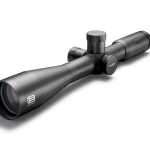
MRAD and MOA
As a military shooter, I learned to range estimate and shoot using MRAD (milliradians or sometimes just mils). Mils are easier to communicate and change on the fly, but I will say that MOA can give you a finer adjustment. Like most things, it comes down to personal preference. I will say that if your shooting buddies are using MOA, stick with MOA. If your buddies shoot MRAD, use MRAD. That will give you the best way to make adjustments in common vernacular, relatively speaking. Either way, use what you’re comfortable with, and you can’t go wrong.
50mm Objective Lens
Overall though, the 8-32x is very usable. It’s still very clear on the high end, and I like how they were able to cram a lot of performance in a relatively small package. At less than 11” overall length and not even 33oz, it’s convenient. The 50mm objective lens offers a lot of light, and for this model, I’d probably opt for using the included sunshade, though it will add length and weight to a pretty light package.
Specifications
- Magnification: 8-32x
- Objective diameter: 50mm
- Tube diameter: 30mm
- Reticle Focal Plane: First Focal Plane (FFP)
- Reticle: HC-2 (MOA)
- Dial Adjustment: MOA
- Linear Field of View: 3.3-13.2’’ at 100 yds
- Illumination: Yes, red
- Eye Relief: 3.39- 3.86”
- Length: 10.63”
- Weight: 32.7 oz
- Price: $1299.99 at Optics Planet
Vudu 3.5-18×50 SFP
Ah, finally, an excuse to talk about the difference between a First Focal Plane (FFP) and Second Focal Plane (SFP)! Ok, so we already discussed the FFP version of this optic. This optic has all the same features (auto-off, included throw lever, fantastic glass, etc.) as the previously discussed FFP version. The FFP 3.5-18 Vudu has more reticle options than the SFP version, which only has an HC-1 MOA crosshair. Maybe that’s not so bad, though?
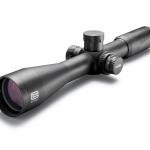
FFP Reticle
With an FFP reticle, your reticle size changes with magnification. The most popular advantage of this is that your holds will be the same at any magnification. Whether or not you can actually see the vertical stadia line hash marks on 4x is another story, but you get the idea. For the Vudu LPVOs, the FFP versions give you the ability to have the sacred “donut of death” on low power, and a finer aiming reticle when you zoom in to higher power.
SFP Reticle
Using an SFP reticle, the reticle stays the same size throughout the magnification range. This means that you need to know your holds at each power and at each range… which gets old for me. My only SFP optic I own is my Vortex Razor, and I only use the holds on that at max power, so it doesn’t bother me.
Personally, I would get this scope in the FFP version for the reticle options and that I prefer FFP over SFP in higher magnification scopes (again, personal preference). This scope is lighter by 5oz if that makes a difference to you.
Specifications
- Magnification: 3.5-18x
- Objective diameter: 50mm
- Tube diameter: 34mm
- Reticle Focal Plane: Second Focal Plane (SFP)
- Reticle: HC-1 (MOA)
- Dial Adjustment: MOA
- Linear Field of View: 5.9-30.2’’ at 100 yds (max to min magnification)
- Illumination: Yes, red
- Eye Relief: 3.39-.4”
- Length: 14.84”
- Weight: 31 oz
- Price: $1119.99 at Optics Planet
Vudu 5-25×50 FFP
Say the following to yourself, like Hulk Hogan… “OH, BROTHER!” This scope is awesome and is my favorite of the batch. After taking a look at this scope, I’m legitimately on the fence about whether to get this or a Nightforce 2.5-20x for my SR25 ACC. This one comes with the aforementioned excellent glass, throw lever, auto-off, etc. However, this thing gives you 25x top end magnification in a tiny, lightweight package. It’s only 11.2” long and weighs less than 30oz. For an optic in this magnification range, that’s quite small. The comparable Vortex Razor 4.5-27x weighs a whole pound more!
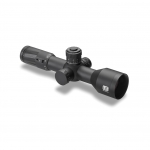
Field View
The field of view on this is also pretty wide at 5x. Tracking was also spot on, doing a standard box test at 100m. This is one of the more expensive offerings of the Vudu lineup, but you definitely get what you pay for.
I’m still not a fan of the illumination, but that’s the same with a lot of FFP optics, so I don’t hold it against EOTech too much. I’m sure they’ll eventually get it right like Leupold and Nightforce did, but it may not be until the next generation Vudu scopes.
Value and Performance
All in all, this is the best value and performance out of all the above scopes. It’s got a good magnification range that will let you shoot out to a mile, it’s light enough to go on a mountain rifle, the H59 is a fantastic reticle, and you get it at a pretty decent price point when you consider the capabilities.
Specifications
- Magnification: 5-25x
- Objective diameter: 50mm
- Tube diameter: 34mm
- Reticle Focal Plane: First Focal Plane (FFP)
- Reticle: MD-3 (MRAD) or H59 (MRAD)
- Dial Adjustment: MRAD
- Linear Field of View: 4.7-23.3’’ at 100 yds
- Illumination: Yes, red
- Eye Relief: 2.96-3.71”
- Length: 11.2”
- Weight: 29.5 oz
- Price: $1599.99 (MD-3); $1699.99 (H59) at Optics Planet
How to Mount a Rifle Scope
There are two parts to mounting a scope to your optic: mounting the optic in the mount itself and securing the mount in an acceptable location on your rifle.
As a disclaimer, there’s a lot of ways to mount an optic, and this is simply “A” way, not necessarily “THE” way (word up, Mandalorian). It’s worked for me in the past, and it’s repeatable enough that I can mount it in the field if I have to… which I have. Hopefully, you can learn from my mistakes.
First, loosely mount your optic in your optic mount. Only tighten the screws down enough to keep the optic in there, but it helps if you can slide your optic forward or backward through your scope rings or one-piece mount. Finger tighten your mount on your upper receiver. The rule of thumb I go back is to have the eyepiece of your optic about even with the rear of the AR receiver. Place your optic on maximum magnification and look through your optic, adjusting forward or backward as necessary. A pro tip is to push your optic as far forward as possible (this is most easily accomplished if you use a one-piece mount). That way, you have a reference point if your scope comes loose for whatever reason.
Now that you’ve figured out where you want your optic and mount to stay, you need to tighten everything up and make sure it’s level. For an AR, you’ll need a vice, armorer’s block or reaction rod, and a pair of small levels. Place the AR in the vice and level it with one of your levels. Then place another level on the elevation dial. Adjust the cant of your scope as necessary to mirror the level on the receiver.
Now for the tricky part: tightening your mount’s rings. In an “x” pattern, hand tighten all of the screws on your mount or rings. Once you’ve got them hand tightened, you’ll need to apply the proper torque. The best tool for this is Fix-it Sticks. They make fantastic, compact tools for this exact function. Every time I go to the range, I make sure I have my Fix-it Sticks. These tools allow you to tighten to the exact inch-pounds required by the manufacturer of your rings or mount. Don’t forget to periodically check to make sure your optic is still level throughout the tightening process. It’s a massive pain in the ass, but I promise it will be worth it when you’re ringing steel at 800m away using good holds you have confidence in.
After this, you can then tighten your rings or one-piece mount down to the proper torque on your upper receiver and shoot with confidence.
*Another pro-tip: use a plumb line to ensure a good level with your vertical stadia line. Simple, but foolproof.
How to Use a Rifle Scope
This all depends on a combination of your optic, ammunition, and rifle platform you use.
Specific to optics, it really depends on two things: your reticle and your adjustment metric. You can make any reticle work, but you need to know exactly how your chosen ammunition performs out of the rifle you want to use. Ammunition manufacturers often publish the muzzle velocity on the box, but it’s using a test barrel of 22” or something no one generally uses. Chronographs are perfect for determining your velocity and how it measures up. After that, you can cheat and save yourself some time by taking advantage of a ballistic app (I use Strelok Pro). The ballistic app will tell you exactly where you need to hold using your reticle with a given projectile and it’s muzzle velocity. If you can afford a Kestrel, I would invest in one.
Bullet Drop Compensator Reticles
Bullet Drop Compensator (BDC) reticles are great, but only if your ammunition and rifle match up perfectly. Most long range precision shooters use a grid (like the Horus 59 reticle in a few of the Vudus above). This allows the shooter to use the same scope for a variety of rifles or ammunition types, assuming you have the data necessary for your ballistic app. I prefer MRADs because that’s what I was taught to use when I was a young infantryman. Many civilian shooters still use MOA but more and more are switching to MRAD. It really boils down to personal preference, but whatever you decide, just make sure that your reticle and dials correspond.
Ammunition
Ammunition is another considerable factor. Mk262 77 grain open tip match is inherently more accurate than M855 62 grain steel penetrator. The distribution of the mass and the mass itself makes it more resistant to crosswinds and other environmental factors. That being said, it will move at a slower velocity because it’s heavier. My SR25 ACC likes to shoot what’s known as Mexican Match ammo (168 grain Sierra Match Kings) more than LR118 (US Army match ammo 175-grain open tip match). You essentially need to test a few things out to see how well your rifle handles specific loads at the intended range you want to use.
Twist Rate
The rifle is the last piece to this to bring everything together. The twist rate of your rifle will determine how fast the bullet spin. You’ll see your twist rate as “1/7,” meaning one twist in seven inches of barrel. As a generality, you use slower twist rates (1/7 or ⅛) for heavier projectiles. Europeans use lighter bullets and usually have 1/10 twist barrels.
Types of Scopes
The types of magnified scopes are basically broken down into two categories: variable power and fixed power.
Variable Powered Scopes
Variable powered scopes are fantastic because you can tailor your magnification to the range or target needed. The downside to variable powered optics is that the scopes tend to be a bit heavier and more complicated, forcing the shooter to know the difference between an SFP or FFP reticle for holdovers. Getting caught in combat with your optic on high magnification when you need a quick and close engagement can be deadly, so I always ensure I keep it on low power.
Fixed Powered Optics
Fixed powered optics, while less usable over a wide array of tasks are still quite useful. Trijicon’s ACOG is perhaps the most successful and rugged magnified combat optic of all time. Many SF folks still like using ACOGs in Afghanistan, though it’s fixed at 4x. Fixed power scopes are lighter and more straightforward, with no need to apply different holdovers since the magnification cannot be changed to affect them.
In the end, it’s up to you to determine which class of optic is right for you. Stay tuned for more gear reviews, range tips, and survival tricks.






Leave a Reply
Your email address will not be published. Required fields are marked *